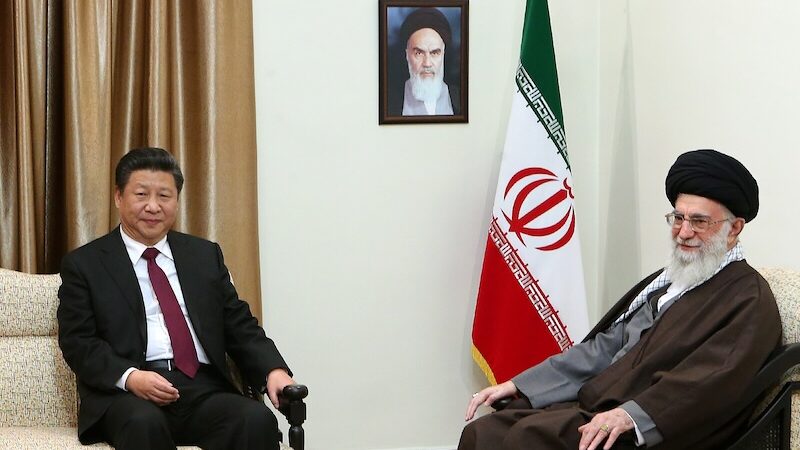America's Middle East Stalemate: Fueling China's Strategic Growth

Welcome to your ultimate source for breaking news, trending updates, and in-depth stories from around the world. Whether it's politics, technology, entertainment, sports, or lifestyle, we bring you real-time updates that keep you informed and ahead of the curve.
Our team works tirelessly to ensure you never miss a moment. From the latest developments in global events to the most talked-about topics on social media, our news platform is designed to deliver accurate and timely information, all in one place.
Stay in the know and join thousands of readers who trust us for reliable, up-to-date content. Explore our expertly curated articles and dive deeper into the stories that matter to you. Visit Best Website now and be part of the conversation. Don't miss out on the headlines that shape our world!
Table of Contents
America's Middle East Stalemate: Fueling China's Strategic Growth
America's decades-long involvement in the Middle East, characterized by periods of intense military intervention and protracted diplomatic efforts, finds itself in a state of stalemate. This prolonged entanglement, marked by shifting alliances and unresolved conflicts, is inadvertently creating a strategic opening for China to expand its influence in the region. This isn't simply a matter of filling a vacuum; China's ascent is a calculated strategy leveraging America's perceived limitations and the region's inherent vulnerabilities.
The Roots of America's Middle East Stalemate:
The current situation is a complex tapestry woven from various threads. The costly and ultimately inconclusive wars in Iraq and Afghanistan have left the US weary of large-scale military interventions. Simultaneously, the rise of non-state actors like ISIS and the enduring Israeli-Palestinian conflict continue to defy easy solutions. The fluctuating dynamics of regional power players, including Iran, Saudi Arabia, and Turkey, further complicate any clear-cut US strategy. This indecisiveness and perceived lack of commitment create an opportune moment for other global powers.
China's Strategic Inroads:
China's approach to the Middle East is markedly different from that of the US. Instead of military dominance, China prioritizes economic engagement and diplomatic pragmatism. This strategy is multifaceted:
-
The Belt and Road Initiative (BRI): This ambitious infrastructure project significantly invests in the region's transportation networks, energy pipelines, and port facilities. This enhances China's economic footprint and strengthens its strategic partnerships with key Middle Eastern nations. The BRI's success hinges on its ability to bypass traditional Western financial institutions and offer alternative financing models.
-
Energy Security: China is a massive consumer of oil and natural gas. Its burgeoning relationship with major oil producers in the Middle East ensures a reliable and stable energy supply, reducing its dependence on other regions. This economic interdependence translates into significant political leverage.
-
Technological Partnerships: China is actively promoting technological cooperation in areas like 5G infrastructure, artificial intelligence, and renewable energy. This offers Middle Eastern nations access to advanced technologies while simultaneously strengthening China's technological influence.
-
Non-Interference Policy: Unlike the US, China generally adopts a non-interventionist stance on regional conflicts. This neutral approach appeals to many nations wary of Western influence and interference in their internal affairs.
Implications for Global Geopolitics:
The shifting power dynamic in the Middle East has significant implications for global geopolitics. The growing Chinese presence challenges the existing US-led order, potentially leading to a multipolar world with several competing spheres of influence. This could reshape global trade routes, energy markets, and even military alliances. The potential for increased competition and even conflict between the US and China in the region cannot be ignored.
Looking Ahead:
America's Middle East stalemate is not simply a regional issue; it's a symptom of a broader shift in global power dynamics. China's strategic growth in the region is a direct consequence of this stalemate. Understanding this dynamic is crucial for navigating the complex geopolitical landscape of the 21st century. The future of the Middle East, and indeed the global order, may well depend on how the US and China navigate this increasingly competitive environment. It's a situation demanding careful observation and thoughtful strategic response from all involved parties. Further analysis of China’s engagement with individual nations in the region, such as Saudi Arabia or the UAE, is essential for a complete understanding of this complex situation. Stay tuned for further updates on this evolving geopolitical landscape.

Thank you for visiting our website, your trusted source for the latest updates and in-depth coverage on America's Middle East Stalemate: Fueling China's Strategic Growth. We're committed to keeping you informed with timely and accurate information to meet your curiosity and needs.
If you have any questions, suggestions, or feedback, we'd love to hear from you. Your insights are valuable to us and help us improve to serve you better. Feel free to reach out through our contact page.
Don't forget to bookmark our website and check back regularly for the latest headlines and trending topics. See you next time, and thank you for being part of our growing community!
Featured Posts
-
 Wife Of Colorado Attack Suspect Details Familys Ordeal In Ice Custody
Jun 22, 2025
Wife Of Colorado Attack Suspect Details Familys Ordeal In Ice Custody
Jun 22, 2025 -
 June 17th 2025 Storms 98 67 Win Over Sparks Full Game Recap
Jun 22, 2025
June 17th 2025 Storms 98 67 Win Over Sparks Full Game Recap
Jun 22, 2025 -
 The Fight For Assisted Dying Navigating Wins And Ongoing Challenges
Jun 22, 2025
The Fight For Assisted Dying Navigating Wins And Ongoing Challenges
Jun 22, 2025 -
 50 Years After Jaws Separating Fact From Fiction In Shark Attack Statistics
Jun 22, 2025
50 Years After Jaws Separating Fact From Fiction In Shark Attack Statistics
Jun 22, 2025 -
 Ex Mlb Stars Presidential Support Hinges On U S Military Action
Jun 22, 2025
Ex Mlb Stars Presidential Support Hinges On U S Military Action
Jun 22, 2025
Latest Posts
-
 Behind The Scenes Of Jaws Iconic Filmmaking Moments
Jun 22, 2025
Behind The Scenes Of Jaws Iconic Filmmaking Moments
Jun 22, 2025 -
 Israeli Aggression Must Cease For Iran To Consider Diplomacy
Jun 22, 2025
Israeli Aggression Must Cease For Iran To Consider Diplomacy
Jun 22, 2025 -
 Official Reveal Megan Fox And Machine Gun Kellys Daughters Name
Jun 22, 2025
Official Reveal Megan Fox And Machine Gun Kellys Daughters Name
Jun 22, 2025 -
 Americas Middle East Policy Creating Opportunities For Chinas Rise
Jun 22, 2025
Americas Middle East Policy Creating Opportunities For Chinas Rise
Jun 22, 2025 -
 Sparks Crushed By Storm Plums Injury Exposes Team Weakness
Jun 22, 2025
Sparks Crushed By Storm Plums Injury Exposes Team Weakness
Jun 22, 2025
